A Personal Tale about the Miracle of Modern Medicine

I used to think I was invincible. Or at least close to it.
I could easily run 3—5 miles without trying, had a resting heart rate of under 50 beats per minute, and I could eat almost anything and not gain any weight.
Then I hit 40.
First, my primary care physician explained that I needed rhinoplasty to fix the deviated septum I had had my entire life. (Yeah, a functional nose job, but it meant I could productively blow my nose for the first time.)
Next on the docket was corrective surgery on my right shoulder to repair a torn labrum, an injury from back when I was 20-years-old.
Then I completely ruptured an Achilles tendon while playing in a Church volleyball tournament. (Yes, we were super competitive.)
Okay, okay, so maybe I wasn't invincible after all.
But still, not too bad for "an old man."
And then February 28th happened.
That was the day my wife and I sat down with Zachary Zavodni, MD, he's the Medical Director of The Eye Institute of Utah in Salt Lake City. He also happens to be an ophthalmologist.
Yup, I had cataracts — in both eyes.
He rated them a 6 and a 5, respectively, on a 1—10 scale. Not good.
And he said, it was why objects appeared fuzzy in the bottom and right sides of my left eye, and generally fuzzy in my right eye.

He was also very clear: Without corrective surgery I would eventually lose my eyesight completely.
As Dr. Zavodni explained,
"Cataract is a reference to a changing of the protein inside the lens of your eye. Anyone who lives to be old enough will develop a cataract. That doesn't mean that every human ends up needing cataract surgery, but the majority do. (In fact), cataract surgery is the most commonly performed surgery in the world."
He went on to explain that the surgery itself would be about a 10-minute procedure where the cloudy lens of the eye is removed and then replaced by a synthetic lens.

He further explained that the synthetic implant is chosen specifically for the optics of the eye in question and the desired outcome, leading typically to "... creating excellent distance vision, excellent reading vision, or in some cases, creating both."
Generally, patients are kept awake during the surgery so they can respond to the doctor's commands/directions during the procedure. However, a local anesthetic is administered, along with a relaxant to keep patients calm while in the surgical suite.
So that was it; I needed cataract surgery on both eyes.
Unfortunately, the soonest I could get on the schedule was 10 weeks from that day. Ugh!
A Bit of Background
By way of context, I had better than 20-20 vision while a teenager and on into my 20s and 30s.
But my distance vision started to decline sometime in my 40s, which meant I became nearsighted. So I got corrective glasses, which worked fine ... for a while.
But over the years I discovered that my distance vision was improving while it was getting hard to read.
[NOTE: As my optometrist explained, as people get older, many will find their vision changes, something often tied to changes in the shape of their eyes.]
Eventually, I stopped using prescription glasses for distance vision and started buying so-called "readers" to support my close-up vision requirements.
But then I got cataracts. Ugh!
So ... What Happened? And ... How's it Going Today?
The day this writeup is published it's now been 13 days since I had the surgery on my left eye, and simply put, the results were phenomenal!
Pre-surgery, the vision in my left eye was between 20-50 to 20-60, meaning that something I should have been able to read at 50- to 60-feet away, I could only read at 20 feet.
However, the vision in my left eye quickly improved to better than 20-20.
In fact, less than 12 hours after that first surgery, I realized that not only could I clearly make out all of the details of a wall clock in one of the rooms in our home, but while the clock face appeared a brilliant white with my left eye, it appeared to be a fuzzy, muted yellow with my right eye.
So I closed my right eye to verify what I thought I had just seen, then did the same with my left eye, with identical results to what I had experienced before.
It was then that I began to cry because I had had no idea how bad my eyesight had become.
At my insistence, I was back at The Eye Institute of Utah the very next morning for corrective surgery on my right eye. (I didn't want to wait the normally recommended two to three weeks between surgeries.)
And again, the results were essentially identical, as I now had 20-20 vision (or better) in my right eye less than a day after surgery.
I literally find myself busting out this song from time to time when I stop and realize how much better my eyesight is.
The surgeries themselves were very straightforward, with no pain or serious discomfort before, during, or after the procedures.
In fact, the worst part was how cold the room temps were in both surgical suites. (Thank goodness for heated blankets.)
Beyond that, I gotta say that the kaleidoscopic colors I saw during both surgeries were pretty spectacular, something a nurse said was quite common during the procedures.
Vision-wise, the clarity and preciseness I now have for anything over 5-feet away is fantastic, and that includes from one side of Salt Lake Valley to the other.
And any fuzziness, or triple- or double-vision, that I used to have is also gone.
Conversely, for close-up needs, I just throw-on my readers and take care of business.
The only drawback of the cataract surgery is that you need to put drops in your eye(s) for four weeks after surgery (which I hate), specifically
- 4X daily with an antibiotic and a steroid for the first week, dropping to
- 3X daily with just the steroid for the 2nd week, then dropping to
- 2X daily with the steroid for the 3rd week, before moving to
- Just 1 drop/day with the steroid for the 4th week.
Oh, and for the first two days after surgery, they insist you wear a protective eye patch over your eye(s) while sleeping.
Apparently they're afraid you might start rubbing your eye/eyes while in dreamland and dislodge a stitch or two.
[NOTE: You can see how totally dorky I looked in the photo below.]

Otherwise, everything is totally groovy.
Two Recommendations and Four Disclosures
The Recommendations
Recommendation No. 1: If you haven't been to an eye doctor recently, you really need to make an appointment. Now.
I don't need to nag you or explain why eyesight is so important, as you already know. Just go.
Recommendation No. 2: I LOVED The Eye Institute of Utah ... everything about it, all of their people, from staff, to techs, to nurses, and (of course), Dr. Zavodni.
And that was before the surgeries.
They were easy to work with, very patient, super supportive, and overall, just seemed to be really good people.
And, of course, I'm super happy with the results!!!
[NOTE: As explained on its website, The Eye Institute of Utah is housed in a 30,000-square-foot facility and was formed nearly 45 years ago as "... the first and largest office-based eye surgical center in Utah."]
The Disclosures
Disclosure No. 1: Dr. Zavodni performed cataract surgery on my brother several years ago, so I had met him before this year. That said, as someone who previously considered himself to be invincible, it never occurred to me that I would ever need an ophthalmologist, let alone need cataract surgery. Twice. LOLOL
Disclosure No. 2: To my knowledge, neither Dr. Zavodni nor anyone at The Eye Institute of Utah knew prior to my cataract surgeries who I was, what I do for a living, or my role as Editor, Publisher, and Founder of Utah Money Watch.
That said, a week before my scheduled surgeries I was contacted by an employee of the Institute and askedif I would be willing to participate in an astigmatism research study during the surgeries? [NOTE: In simplest terms, astigmatism refers to an irregular curvature of the cornea, and apparently both of my eyes had an astigmatism.]
By participating in the study, the cost to repair my astigmatisms ($1,800.00 per eye) would be covered by the sponsoring organization. After discussing this option with my wife, we decided I should to participate in the study for both eyes.
Disclosure No. 3: However, I learned after-the-fact that the study sponsor would also give me a $200 gift card for each procedure, which they did. As a result, with our insurance, our out-of-pocket costs for both cataract surgeries was only $90.
Disclosure No. 4: The funny thing is that I don't even know the name of the organization that sponsored the study.
Seriously, I don't.
PUBLISHER'S NOTE
At approximately 8:30am MT on Monday, 20 May 2024, this article was originally published and distributed to our Subscribers.
However, if you are seeing this writeup for the first time sometime after this date, you can be notified immediately when we publish future items by subscribing, FOR FREE, to Utah Money Watch.
Doing so takes less than 30 seconds and can be done on any page on the Utah Money Watch website.
Simply,
1. Click on a Blue & White "Subscribe" button on any Utah Money Watch webpage,
2. Enter in your name in the proper field in the popup window that appears on-screen, and
3. Enter your preferred email address in the proper field too.
That's it. And "Yes," it really is that simple.
And ... it IS free.
So please subscribe today; doing so helps show the value of Utah Money Watch to potential sponsors.
Thank you.
Team Utah Money Watch




Comments ()